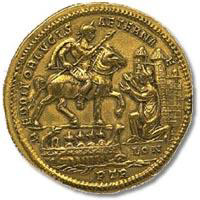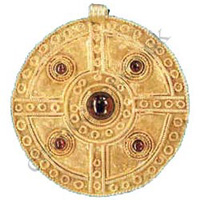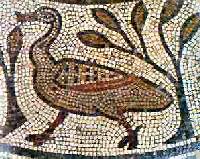 | Blogger News | Contact | Buy Book |
|
STORIES & POEMS
::::::::::::::::::::
|

Stories and PoemsThe Romans have definitely left their mark in Britain. Daily excavations are going on. It can be followed on TV. It's a program called: "Time Team." After air reconnaissance, ditches are dug. So much is found that one can well imagine life at that time. Farmsteads, foundries, palaces and huge walls have been discovered, besides cemeteries. The best finds to my mind are the so well preserved mosaic floorings. Some are complete, and others damaged. Once a second mosaic flooring had been found underneath the first one, almost like a "change of carpet." Of course jewellery and weapons were found too, besides coins and many, many other things one can find in Museums. About 4 years ago a Museum has been built in Cirencester, (Corinium during the occupation) because of the amount of artefacts found in this area.
The Romans arrived in Britain in AD43 with 4 Legions (40,000 men). Emperor Claudius was involved in the first conquests for a while. After crossing the river Thames to Colchester, (then Camolodunum) they fanned out over the whole country, fighting the tribes. Eventually the Legions marched over the marvellous roads they had built. They provided access to all regions. The most famous road is the South to North road. The roads are still there, but covered through time with earth and grass. While the fighting still continued, the King of the Iceni made a pact with the Romans that after his death half of his territory should go to his elder daughter and the other half to the Roman Emperor, but it was disregarded. The King's Widow Boudicca rebelled and attacked (AD61). The IX Legion was wiped out, but the XIV Legion counter attacked and enslaved the Iceni. Queen Boudicca was flogged and her daughters dishonoured. Queen Boudicca poisoned her daughters and then herself. In the meantime the British town London (Londinium) had been conquered; it thrived and grew with trade. In the years 78-84AD, Agricola was the Governor of Britain. He was then recalled and Hadrian arrived. He decided to build the "Hadrian Wall," under his direction and fortifications (120AD) along the Cheviot Hills in Scotland, because of ambush attacks from the North. The wall is still there. I went to see it, but now it is only about 2-3 feet high. Originally it was 6 foot high with many watchtowers 20 feet high and 7 ½ feet in depth. There were 15 Forts along the 80 mile long wall, each with all the facilities for families, stable for 500 horses, workshops and granaries. An invitation card for an afternoon visit has been found sent by a women to another one from a different Fort. ### Recently in London a part of the original wall, which then surrounded Lindonium has been discovered. This wall measured then 22 feet in height and 9 feet in depth Where I live here in Bristol, we are surrounded with reminders of the Roman occupation. The road, I use daily, is the South to North Roman road, now a main commuter route. It passed through the Roman Fort in Bedminster. It had been only a temporary Fort. When all of Britain was in Roman hands it was abandoned. In Fishbourne, a Roman palace had been discovered in 1960. It had 100 rooms. All had mosaic flooring, mostly well preserved. These patterns are on show in the Corinium Museum not far from Bristol.
Also a feudal villa has been discovered, which had been occupied by a Britain, a trader, who became Roman. The works on all buildings and walls were very elaborately done by slaves. Nearby "Gatcombe" was of agricultural importance. A great tourist's attraction is the nearby town of Bath. There Romans used the hot spring and had built a large bath-area around it. "The Roman Bath" is fully functional again. A lot of work had to be done and money had to be found to do this. This hot spring 46C, releases 13 litres every second. It has 43 healing properties. This is only an outline about the Roman occupation. I don't want to bore people by given a history lesson, but only hope to give a glimpse into this era I find very fascinating.
© 2006 Gisela Cooper |
| ©2001-2016 Content by Gisela Cooper | Web Site by LucarInfo.com | Sitemap | Privacy |



